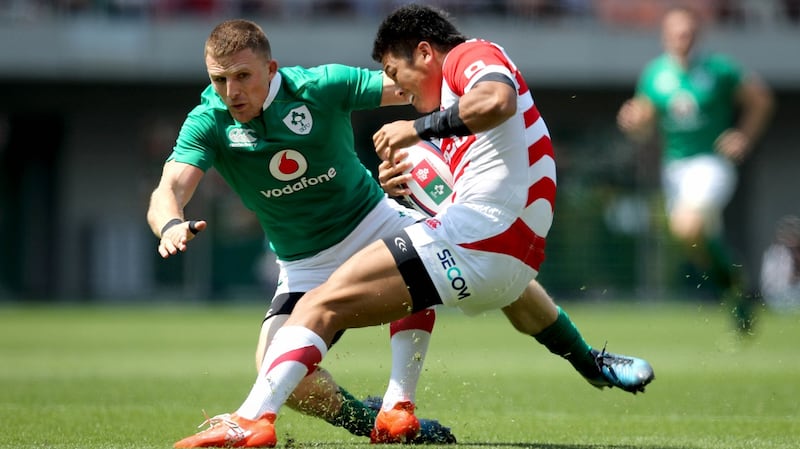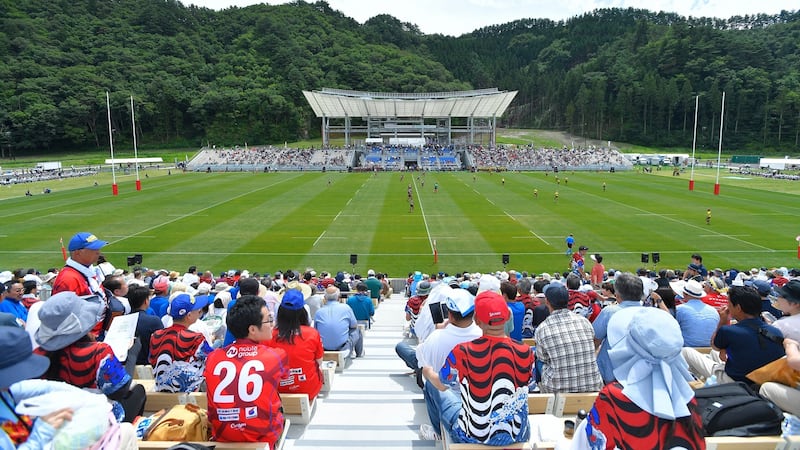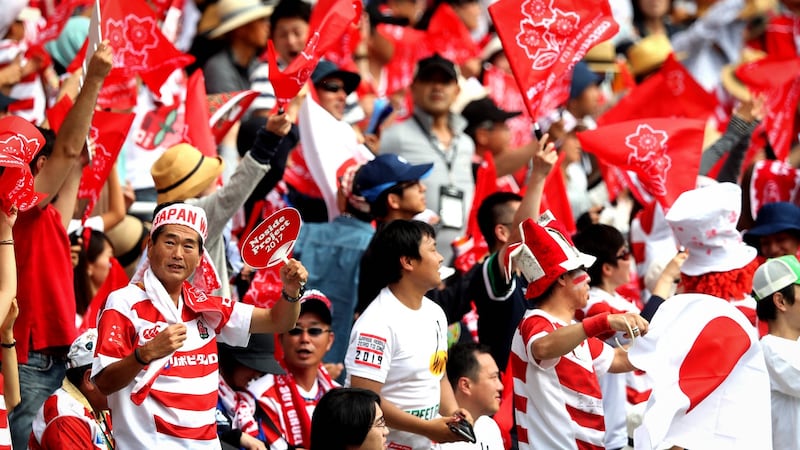When Eddie Jones was the coach of Japan he once cancelled a training session and gave everyone the day off. In response, he had never seen his players so upset.
Jones had felt his players were trudging towards training as if “off to prison”, compelled to do so by an overbearing sense of duty rather than enjoyment. So to make his point, and only too aware of the reaction he would get, he denied them the chance to fulfil it, before explaining: “You’ve got to play sports with some love in your heart.”
The Jones story sprang to mind when, after a recent training session in the foothills of Mount Fuji, the Yamaha Jubilo and ex-Tonga centre Viliami Tahitu’a outlined what he saw as the biggest changes to rugby in Japan since the 2015 World Cup and their famous win over South Africa. “The Japanese don’t love the contact, but now you see them standing in front of you and they’re keen to tackle you.”
In other words, tackling out of a sense of duty, however strong, will only get you so far and as the hosts of the 2019 World Cup come to Twickenham to face England for the first time on Saturday, it is worth understanding how the man now coaching their opponents, helped change their rugby culture.
Standing just a few metres away from Tahitu’a is his Yamaha team-mate Ayumu Goromaru, the face of the stunning upset against the Springboks three years ago, having scored 24 points in Brighton. It says a lot about rugby in Japan that Goromaru has not played a Test match since then but is, by a distance, the most famous player in his home country to the extent that he is revered. There is even a lifesize bronze statue of him, making his Jonny Wilkinson-esque kicking pose, at the nearby Shizuoka Stadium Ecopa in Fukuroi, situated amid Japan’s green tea fields.
Commercial benefits
He stands out on the training field because he has a shiny, celebrity status about him. The caps have dried up but the commercial benefits clearly have not and while he appears to have little chance of representing Japan at next year’s World Cup, no one embodies the link between the national team and the wider public better. As Tahitu’a says, “Last World Cup, coming home, they were treated like princes and kings.”
Rugby certainly has its followers in Japan, and a playing population of about 125,000, but while they are passionate they are not as plentiful as the World Cup organisers would like amid fears of empty seats at stadiums next year. To sum up rugby’s place on the landscape, the Yamaha coach is Katsuyuki Kiyomiya and he is best known in Japan because his son Kotaro is a rising star in the world of baseball – comfortably the country’s most popular sport.

Kiyomiya has previously worked with Jones at Suntory Sungoliath and was seen by many as the outstanding candidate to replace him after the 2015 World Cup until they had a public falling out on the eve of the competition. Asked if Jones did much to develop rugby in a wider sense, rather than the national team during his tenure, Kiyomiya simply replied: “I do not like him very much.”
As well as Tahitu’a and Goromaru, Kiyomiya has at his disposal the usual blend of professional Japanese players, overseas imports and the amateur players who are employed to work, as well as play, for the companies they represent – in this case, Yamaha. It emerged this week that Japan’s players are receiving only 2,000 yen (€15.33) as a daily allowance as they prepare to face England, but just as remarkable is that the amateurs often start training at 6am before going to work later that morning, then back out to the training field in the afternoon.
That kind of daily routine would not seem to give rise to too much love in their hearts but that is the strange predicament in which Top League clubs find themselves. Rugby is a corporate sport in Japan, big in universities too, and so the prestige of acquiring overseas stars is obvious and the biggest is former All Black Dan Carter, currently plying his trade with the Kobelco Steelers.
Acting as an outpost for ageing players from the Sanzaar countries – often in positions where the age-old problem of finding Japanese players with the physical stature required remains rife – can be problematic for the development of homegrown youngsters, but Kiyomiya sees the short-term benefits. “Those players [late in career] are highly skilled, however in the future they may be younger players, with excellent skill,” he says. “Also there are so many ex-All Blacks here; they have excellent skills.”
He alludes to the increase in current All Blacks seeking sabbaticals in Japan. Beauden Barrett is the latest to be linked with the move as New Zealand Rugby strengthens its ties with the Top League, perceiving losing players temporarily to Japan as the lesser of two evils compared with England or France.
Bureaucracy
Since joining Super Rugby in 2016, the Sunwolves have had a positive effect on developing domestic players, according to the national team captain Michael Leitch. And Jones agrees: “The young guys play Super Rugby so are playing against the best players in the world on a weekly basis.” But to understand why there are concerns Japan have not capitalised on the success story as much as they ought to, you must first realise the tangled web of committees and bureaucracy that governs the sport.

Jones left after the 2015 World Cup as planned, but with a parting shot at the conservative Japanese union. He is keeping his counsel as to what he really thinks of the structures in place in England until he leaves his current post but while he obviously feels he operates with one arm tied behind his back, he gave the impression things were far worse in Japan.
That is unlikely to feature in the film being made about the “Miracle of Brighton” and indeed, there is nowhere near as much co-operation between next year’s organising committee and the Japan union as you may think, even if they would at least agree that the stronger the national team is, the more popular the event will prove. This is where Jamie Joseph comes in, as Jones’s replacement and the man tasked with ensuring the host nation does not fail to make it out of the pool for the second World Cup in a row.
There have been some positive results and in June they beat Italy and held Georgia scoreless in a 28-0 victory while in November drew away to France. But there have been some hammerings too and while they scored five tries against New Zealand this month, they conceded 10 to what was a second-string side, having lost to a World XV the week before.
Regardless, Jones believes they are now a “serious member of the rugby community”, pointedly highlighting how they rearranged the Top League schedule to allow them to convene earlier for the autumn calendar than they would have in his time, but the inconsistency of their performances is a worry. In short, the wider public will approach next year’s World Cup with hope rather than expectation.

How they approach the tournament as a whole is another matter but as a signpost, the 46,143 attendance for New Zealand’s victory over Australia in Yokohama last month was promising. While it may have been a concern to have been sat in near silence for large spells of the match, it must be hoped that when Japan are playing next year that will not be the case.
Increasingly, you sense Yokohama will play a pivotal role in the success of the tournament. The 72,000-seater stadium has, after all, stepped in to host the final (it will stage seven matches in total including both semis and England’s pool match against France) after it became clear the new showpiece stadium for the 2020 Tokyo Olympics will not be ready in time for the World Cup.
The city is less than half an hour away from Tokyo on the shinkansen (bullet train) and has a popular waterfront area in the bay, as well as Noge – its lively bar and restaurant district. Think a smaller, more sanitised version of London’s Soho, bound to be popular with travelling supporters looking to quench their thirst. If there is a concern however – and this goes for all host cities – it is that the western drinking culture may come as a shock. After all, recent matches in Oita have been known to run out of beer by half-time and one bar owner in Yokohama seemed perplexed by the idea that there will be a noticeable upturn in trade during the tournament.
If supporters – about 400,000 are expected in total – will descend en masse to Yokohama however, there are concerns that smaller cities in the north and south will not be as well attended, hence the drive to encourage travelling fans to mix matches with tourist excursions.
Ultimately though, the best way to guard against empty seats will be a fast start from Japan and it helps that they raise the curtain against Russia, who they will expect to beat resoundingly. A cursory look at the World Cup schedule suggests their final pool match against Scotland will be crucial and victory could well mean reaching the quarter-finals and as a result, more princes and kings. As Goromaru says: “I hoped that after the 2015 World Cup we [would] get more rugby fans; that we were able to spread rugby to people. We expect more and more fans after the World Cup next year.” Or to paraphrase, the hope is there will be more love for rugby in their hearts.
– Guardian
Gerard Meagher travelled to Japan courtesy of the Japan External Trade Organization
















